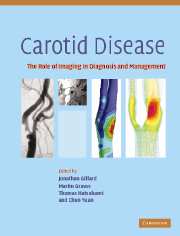Book contents
- Frontmatter
- Contents
- List of contributors
- List of abbreviations
- Introduction
- Background
- Luminal imaging techniques
- Morphological plaque imaging
- Functional plaque imaging
- 19 Nuclear imaging for the assessment of patients with carotid artery atherosclerosis
- 20 USPIO – enhanced magnetic resonance imaging of carotid atheroma
- 21 Gadolinium-enhanced plaque imaging
- 22 Carotid magnetic resonance direct thrombus imaging
- Plaque modelling
- Monitoring the local and distal effects of carotid interventions
- Monitoring pharmaceutical interventions
- Future directions in carotid plaque imaging
- Index
- References
21 - Gadolinium-enhanced plaque imaging
from Functional plaque imaging
Published online by Cambridge University Press: 03 December 2009
- Frontmatter
- Contents
- List of contributors
- List of abbreviations
- Introduction
- Background
- Luminal imaging techniques
- Morphological plaque imaging
- Functional plaque imaging
- 19 Nuclear imaging for the assessment of patients with carotid artery atherosclerosis
- 20 USPIO – enhanced magnetic resonance imaging of carotid atheroma
- 21 Gadolinium-enhanced plaque imaging
- 22 Carotid magnetic resonance direct thrombus imaging
- Plaque modelling
- Monitoring the local and distal effects of carotid interventions
- Monitoring pharmaceutical interventions
- Future directions in carotid plaque imaging
- Index
- References
Summary
Introduction
The use of magnetic resonance imaging (MRI) for evaluation of atherosclerotic plaque has mostly focused on morphological aspects of the disease. The ability of MRI to provide high resolution depictions of the vessel lumen, outer wall boundary and plaque substructures is well established (Yuan and Kerwin, 2004). Such information, however, tells only part of the story of the plaque. Microscopic processes, such as infiltration of macrophages, can have profound effects on disease progression. Fortunately, MRI offers the ability to assess such processes through the use of injected contrast agents.
The development of contrast agents for MRI is a rapidly expanding area, with most agents utilizing gadolinium and its ability to shorten MR relaxation times T1 and T2. In T1-weighted images, regions with accumulation of the agent are characteristically brighter and in T2-weighted images, high concentration regions appear darker. Chelates of gadolinium including Gd-DTPA are currently available for clinical use and were initially approved for applications in detecting lesions of the central nervous system. Experimental uses under investigation include magnetic resonance angiography (MRA) and MRI of atherosclerosis. Techniques exist in these areas for first pass imaging in which the agent is restricted to the blood stream, late phase enhancement in which the agent has diffused into the extracellular space of the tissue, and dynamic imaging in which the transfer from the blood stream to the tissue is observed over time.
This chapter reviews the state of the art in contrast-enhanced MRI of atherosclerosis.
- Type
- Chapter
- Information
- Carotid DiseaseThe Role of Imaging in Diagnosis and Management, pp. 288 - 301Publisher: Cambridge University PressPrint publication year: 2006

